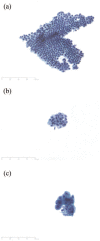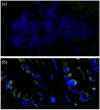Optimal tissue sampling during ERCP and emerging molecular techniques for the differentiation of benign and malignant biliary strictures
- PMID: 33948111
- PMCID: PMC8053835
- DOI: 10.1177/17562848211002023
Optimal tissue sampling during ERCP and emerging molecular techniques for the differentiation of benign and malignant biliary strictures
Abstract
Patients with cholangiocarcinoma have poor survival since the majority of patients are diagnosed at a stage precluding surgical resection, due to locally irresectable tumors and/or metastases. Optimization of diagnostic strategies, with a principal role for tissue diagnosis, is essential to detect cancers at an earlier stage amenable to curative treatment. Current barriers for a tissue diagnosis include both insufficient tissue sampling and a difficult cyto- or histopathological assessment. During endoscopic retrograde cholangiopancreatography, optimal brush sampling includes obtaining more than one brush within an individual patient to increase its diagnostic value. Currently, no significant increase of the diagnostic accuracy for the new cytology brush devices aiming to enhance the cellularity of brushings versus standard biliary brush devices has been demonstrated. Peroral cholangioscopy with bile duct biopsies appears to be a valuable tool in the diagnostic work-up of indeterminate biliary strictures, and may overcome current technical difficulties of fluoroscopic-guided biopsies. Over the past years, molecular techniques to detect chromosomal instability, mutations and methylation profiling of tumors have revolutionized, and implementation of these techniques on biliary tissue during diagnostic work-up of biliary strictures may be awaited in the near future. Fluorescence in situ hybridization has already been implemented in routine diagnostic evaluation of biliary strictures in several centers. Next-generation sequencing is promising for standard diagnostic care in biliary strictures, and recent studies have shown adequate detection of prevalent genomic alterations in KRAS, TP53, CDKN2A, SMAD4, PIK3CA, and GNAS on biliary brush material. Detection of DNA methylation of tumor suppressor genes and microRNAs may evolve over the coming years to a valuable diagnostic tool for cholangiocarcinoma. This review summarizes optimal strategies for biliary tissue sampling during endoscopic retrograde cholangiopancreatography and focuses on the evolving molecular techniques on biliary tissue to improve the differentiation of benign and malignant biliary strictures.
Keywords: chromosomal imbalance; epigenetics; immunohistochemistry; mutation; next-generation sequencing.
© The Author(s), 2021.
Conflict of interest statement
Conflict of interest statement: The authors declare that there is no conflict of interest.
Figures


Similar articles
-
Endoscopic and novel approaches for evaluation of indeterminate biliary strictures.J Formos Med Assoc. 2025 May 27:S0929-6646(25)00266-9. doi: 10.1016/j.jfma.2025.05.036. Online ahead of print. J Formos Med Assoc. 2025. PMID: 40425411 Review.
-
Clinical approach to indeterminate biliary strictures: Clinical presentation, diagnosis, and workup.World J Gastroenterol. 2023 Sep 28;29(36):5198-5210. doi: 10.3748/wjg.v29.i36.5198. World J Gastroenterol. 2023. PMID: 37901449 Free PMC article. Review.
-
Mutation Profile and Fluorescence In Situ Hybridization Analyses Increase Detection of Malignancies in Biliary Strictures.Clin Gastroenterol Hepatol. 2017 Jun;15(6):913-919.e1. doi: 10.1016/j.cgh.2016.12.013. Epub 2016 Dec 23. Clin Gastroenterol Hepatol. 2017. PMID: 28017843
-
High Diagnostic Yield of Endoscopic Retrograde Cholangiopancreatography Brush Cytology for Indeterminate Strictures.J Can Assoc Gastroenterol. 2022 May 5;5(5):234-239. doi: 10.1093/jcag/gwac011. eCollection 2022 Oct. J Can Assoc Gastroenterol. 2022. PMID: 36196274 Free PMC article.
-
EUS-FNA is superior to ERCP-based tissue sampling in suspected malignant biliary obstruction: results of a prospective, single-blind, comparative study.Gastrointest Endosc. 2014 Jul;80(1):97-104. doi: 10.1016/j.gie.2013.12.031. Epub 2014 Feb 19. Gastrointest Endosc. 2014. PMID: 24559784 Clinical Trial.
Cited by
-
Optimal Management of Patients with Advanced or Metastatic Cholangiocarcinoma: An Evidence-Based Review.Cancer Manag Res. 2021 Oct 27;13:8085-8098. doi: 10.2147/CMAR.S276104. eCollection 2021. Cancer Manag Res. 2021. PMID: 34737637 Free PMC article. Review.
-
Histological assessment of new cholangioscopy-guided forceps in ERCP biliary stricture sampling: a blinded comparative study.Endosc Int Open. 2022 Sep 14;10(9):E1233-E1237. doi: 10.1055/a-1897-4686. eCollection 2022 Sep. Endosc Int Open. 2022. PMID: 36118635 Free PMC article.
-
Using Endoscopy in the Diagnosis of Pancreato-Biliary Cancers.Cancers (Basel). 2023 Jun 28;15(13):3385. doi: 10.3390/cancers15133385. Cancers (Basel). 2023. PMID: 37444495 Free PMC article. Review.
-
Fluorescence In Situ Hybridization in Primary Diagnosis of Biliary Strictures: A Single-Center Prospective Interventional Study.Biomedicines. 2023 Mar 2;11(3):755. doi: 10.3390/biomedicines11030755. Biomedicines. 2023. PMID: 36979734 Free PMC article.
-
Morphologic and molecular diagnostic criteria of malignancies in biliary strictures.Histol Histopathol. 2025 Apr;40(4):443-452. doi: 10.14670/HH-18-811. Epub 2024 Sep 10. Histol Histopathol. 2025. PMID: 39381890 Review.
References
-
- Graziadei IW, Schwaighofer H, Koch R, et al.. Long-term outcome of endoscopic treatment of biliary strictures after liver transplantation. Liver Transpl 2006; 12: 718–725. - PubMed
-
- Draganov P, Hoffman B, Marsh W, et al.. Long-term outcome in patients with benign biliary strictures treated endoscopically with multiple stents. Gastrointest Endosc 2002; 55: 680–686. - PubMed
-
- Tummala P, Munigala S, Eloubeidi MA, et al.. Patients with obstructive jaundice and biliary stricture +/− mass lesion on imaging: prevalence of malignancy and potential role of EUS-FNA. J Clin Gastroenterol 2013; 47: 532–537. - PubMed
Publication types
LinkOut - more resources
Full Text Sources
Other Literature Sources
Research Materials
Miscellaneous

